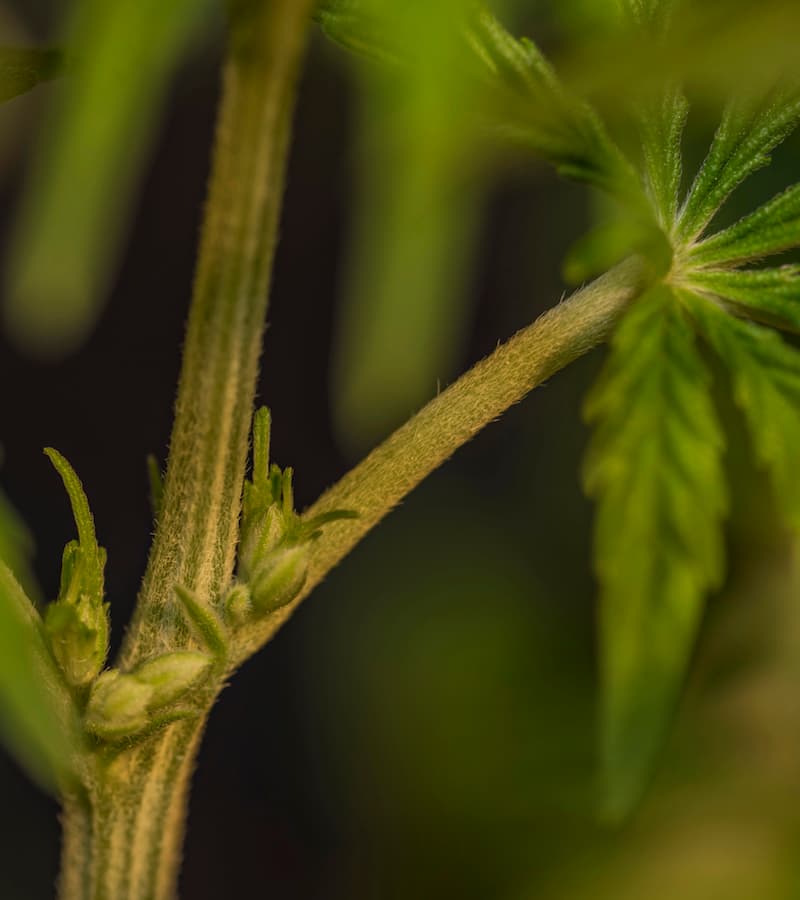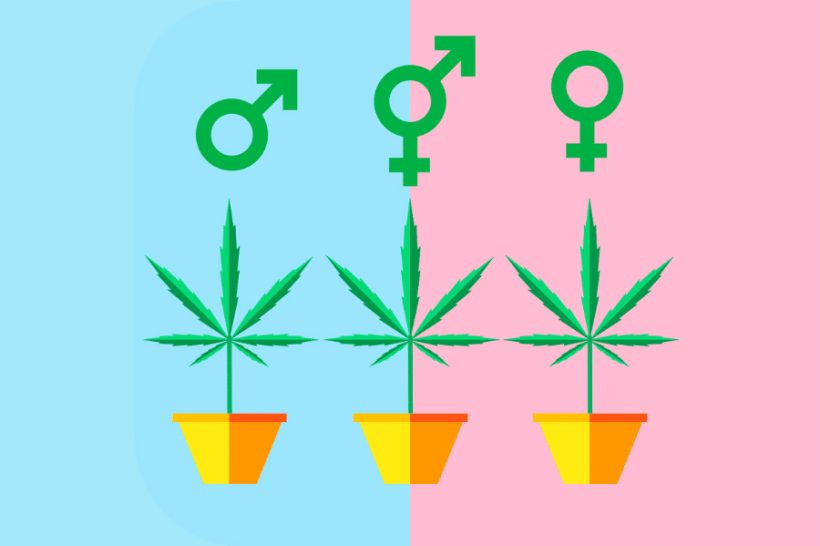How Can You Tell If Marijuana Is Male Or Female?
Marijuana plants announce their ‘gender reveals’ in the form of pre-flower buds. These small orb-like growths take shape where leaf stalks branch out from the main stem. The boys go first, typically showing their buds around four weeks after germination. The girls take a couple of weeks longer. Pre-flowering lasts for a couple of weeks. During this time the males sprout small round pollen sacs which cluster together resembling bunches of bananas. Meanwhile, the females make their identity known by showing the hair-like tentacles of their developing pistils.


More changes come as plants transition to full flowering. There’s often a growth spurt, with males growing taller while the females spread wider and develop denser leaf clusters. Differences become even more pronounced as flowers emerge. Both genders become aromatic and develop a calyx at the center of the flower — but with differences.
Male plants grow small, bell-shaped flowers with small, hairless calyxes surrounded by pollen sacs. Female plants, on the other hand, produce teardrop-shaped flowers with large calyxes showing white hairs. As they reach sexual maturity, the part of the female calyx known as the trichome develops the resin glands where a majority of the plant’s cannabinoids, terpenes, and flavonoids are formed.
What Happens If You Don’t Separate Male And Female Marijuana Plants?
When cannabis plants are left alone, nature takes its course. The males reach sexual maturity in five to six weeks, at which their full-developed pollen sacs burst open, scattering pollen to the winds. If this pollen reaches the resin-rich flowers of the female plant, fertilization takes place, and the female plant transfers her energy from resin secretion to seed production.
Wild-growing marijuana has relatively low levels of the cannabinoids prized by recreational and medical cannabis users. A sample of wild-grown marijuana from northern Thailand showed an average of 2%THC content. Separating the sexes put the males at less than 1% THC, which is typical for cultivars both wild or domesticated. Meanwhile, the females growing in mixed company capped out at around 3% THC.
Which Cannabis Plant Do You Smoke, Male Or Female?
The key to high-yield cannabis cultivation is separating the males from the females. When there are no males around to provide pollination, the females enter what could be called a hyper-virgin state. Their flower buds swell and grow up to three times as long, while sticky resin production increases dramatically in hopes of capturing any elusive pollen that might float by. It is during this stage of prolonged virginity that concentrations of terpenes, flavonoids, and cannabinoids such as THC are two to five times greater than in fertilized plants.
Generations of growers have exploited this phenomenon to produce modern strains of enhanced cannabinoid marijuana. As a result, most commercially viable cannabis and cannabis-based products are derived from female plants that are grown in the botanical equivalent of a convent, with every possible effort made to keep them away from male influences. The practice of preventing seed production to boost cannabinoid production came to be known as “sinsemilla,” which is Spanish for “without seed”.
Can Female Cannabis Plants Pollinate Themselves?
Nature has a way of solving problems, and when the problem is a lack of male pollen donors, female cannabis plants may go to plan B. Some six to eight weeks after they first become ripe and ready, a percentage of pollinated female marijuana plants start showing male traits and develop pollen sacs. The hermaphrodites, known as “hermies” to cannabis growers, can wreak havoc in a grow room. Hermies not only self-pollinate, they also fertilize any receptive females in the vicinity. This unwanted sexual activity can reduce cannabinoid and terpene content for an entire crop, create unwanted cross-breeding and may pass on their gender-crossing tendencies to future generations.
Can You Smoke Hermaphrodite Cannabis Flower?
Unlike male marijuana, which has very low levels of cannabinoids, hermie plants retain some percentage of their sister plants. The amount can vary significantly based on the strain and other factors. So there is nothing wrong or dangerous about lighting up hermaphrodite cannabis.
The real question isn’t “can you?”, it’s “why would you?”. Home growers facing a limited harvest might decide to salvage the hermies, remove the seeds and get at least something back for their horticultural efforts. Fortunately, hermaphrodite consumption isn’t an issue for the vast majority of medical marijuana users who obtain their products from commercial sources. Growers go to great lengths to protect against hermie contamination of their crops.
What Can You Do With Male Cannabis Plants?
While most growers promptly remove male plants to prevent pollination, these plants still have value. They can be grown separately from females and processed for concentrates and hemp products. And because they contribute 50% of the genetic makeup of a cannabis plant, keeping a few males on deck for procreational purposes is helpful for breeders looking to create new strains or reinforce certain desirable traits of an existing strain.
Do You Have Questions About Medical Marijuana?
CannaMD‘s network of state-licensed, certified physicians is always available to answer your questions, provide advice, and streamline the process of obtaining medical marijuana. To find out if you qualify for medical marijuana, simply complete our free online application, or call (855) 420-9170.




